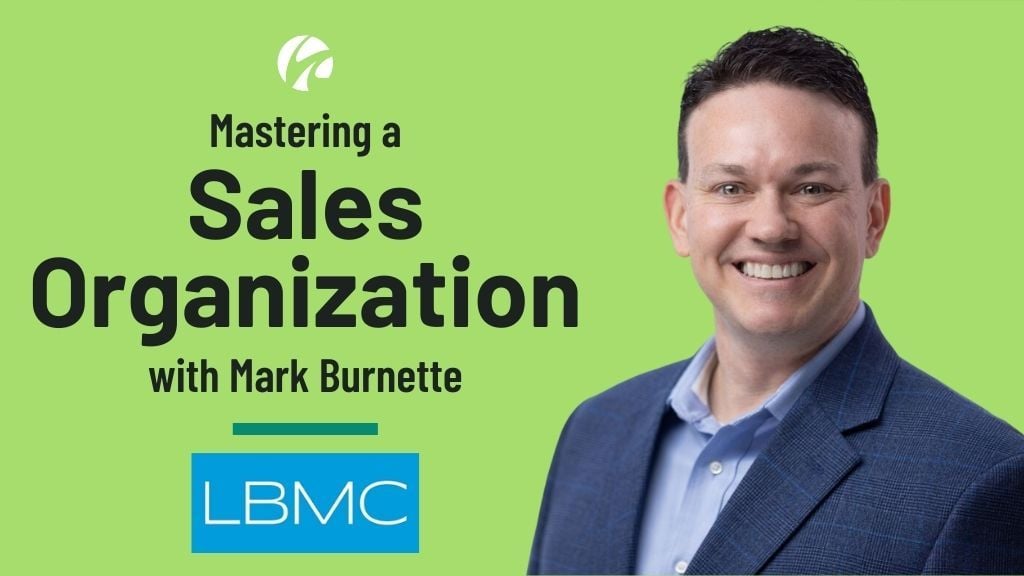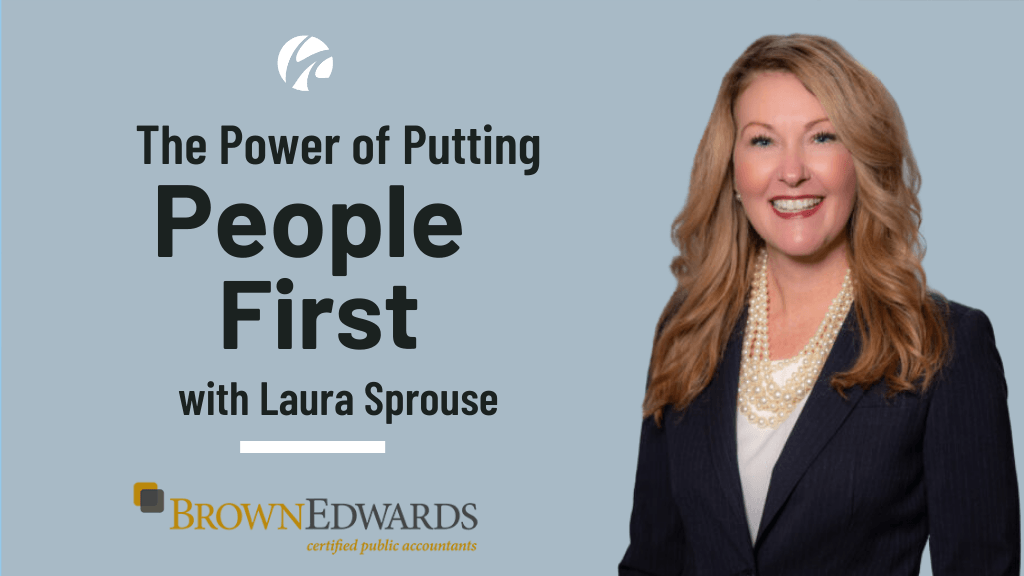3 min read
Mastering a Sales Organization in a CPA & Advisory Firm: Insights from Mark Burnette at LBMC
In our ongoing pursuit of understanding how culture impacts sales organizations within the realm of accounting firms, we had the privilege of...
6 min read
by:
 Brian Blaha, CPA, and Dr. Rachel Anevski
on
Oct 14, 2025
Brian Blaha, CPA, and Dr. Rachel Anevski
on
Oct 14, 2025

Table of Contents
.png?width=1024&height=576&name=Blog%20-%20Accounting%20Talent%20Mix%20(1).png)
The traditional accounting firm structure, based on a pyramid of leverage with junior staff feeding work to senior partners, is becoming increasingly obsolete. As artificial intelligence transforms service delivery, forward-thinking firms are discovering that their workforce needs to change from a pyramid into something more like a diamond: fewer people at the bottom handling transactional work, more expertise concentrated in the middle delivering advisory services, and sustained leadership at the top.
This shift isn't just about technology adoption. It's about fundamentally rethinking the kinds of talent accounting firms need, how to measure employees, and how to ensure the profession maintains its leadership pipeline while embracing automation. The real question for firm leaders isn’t if change is coming: it’s whether your firm will be ready to capitalize on these opportunities as they continue to emerge.
The accounting industry's traditional organizational structure is under growing pressure. AI is already automating tasks that once required large cohorts of entry-level employees. As a result, the emerging talent model is leaner at the bottom, deeper in mid-career professionals with domain expertise, and still anchored by steady leadership at the top.
At the same time, this new dynamic accelerates the industry’s pivot toward advisory services. Many firms have been building these capabilities for years, and AI may finally provide the scale they’ve been seeking. Advisory work delivers higher-value insights, stronger client relationships, and better margins—but success requires more than technology. As clients themselves lean on AI for answers, it’s judgment, communication, and the ability to build trust that will ultimately set firms apart.
This creates real opportunity for efficiency and margin growth, but it also raises a critical concern: if fewer professionals gain foundational experience early in their careers, who will become tomorrow’s leaders?
Entry-level positions have traditionally served as training grounds where new professionals learned fundamental accounting principles, developed professional judgment, and built the foundational experience necessary for leadership roles. In this new talent pyramid, firms must reimagine these positions.
The apprenticeship model, as it exists today, needs a reset. Junior staff should spend their early careers actively learning, being exposed to different areas of the business before evolving into roles that demand domain expertise.
Our industry’s current training models aren’t fit for this purpose: historically, active CPAs with full client workloads have lacked the bandwidth to develop meaningful curriculums to support employee development. At the same time, training and mentorship responsibilities have often been thrown upon individuals that are ill-qualified for these responsibilities, resulting in sub-par mentorship experiences.
Given the changing nature of work, firms must now create intentional opportunities for mentorship and skill development that once happened naturally through the work itself. That starts with top-down training that then cascades through the organization.
Historically, many accounting leaders didn’t choose leadership so much as they arrived there by virtue of deep technical acumen. In fact, more than half of professionals were never asked if they wanted to lead — they simply accumulated expertise until promotion became inevitable. But technical mastery doesn’t guarantee leadership skills, and the profession can’t afford to continue relying on accidental leaders in today’s environment. Investing in training leaders and mentors across your firm is the only way to ensure consistent, high-quality apprenticeship experiences for junior employees.
As the workforce structure progresses, so too must the skills firms prioritize when hiring and developing talent. The accountants who will thrive in an AI-enhanced environment possess a fundamentally different mix of capabilities than those who succeeded in the traditional model.
Modern accounting professionals must understand not just how to use AI tools, but when and why to deploy them effectively. This means knowing which processes are suitable for automation, how to interpret AI-generated results, and how to maintain quality control. AI literacy doesn’t mean that employees have to become programmers, but they do need to understand how to leverage technology effectively.
As routine tasks become automated, the human elements of accounting gain importance and will set firms apart. Professionals who can interpret complex financial data, navigate ambiguity, and build strong client relationships will deliver superior outcomes. These cognitive and emotional skills, ranging from understanding business context to effective communication skills, remain out of reach for machines, ensuring that human judgment stays central even in an AI-driven profession.
AI excels at pattern recognition and routine processing but struggles with complex, nuanced situations that demand deep domain knowledge. Tax professionals who understand intricate regulatory requirements, auditors who assess sophisticated risk scenarios, and advisory specialists who synthesize multiple data sources into strategic recommendations will remain in high demand.
Tomorrow's accounting professionals must adopt a mindset of perpetual learning: a responsibility that falls both upon employees themselves and their leaders. Today's AI tools will develop rapidly, and professionals who quickly master new technologies and help their firms stay current become invaluable assets. The most successful firms will identify and develop these individuals as internal champions who can guide broader technology adoption across the organization.
Aspiring leaders must have a commitment to perpetual learning embedded in their ethos. By nature, many CPAs already fit this bill: accounting regulations, tax laws, and best practices have always been fluid, and CPAs have always remained on top of developments to ensure their clients remain compliant. However, the rapid advancements in today’s accounting industry demand that firms take on a more flexible mindset, broaden their CPE programs, and remain open to exploring change.
Legacy KPIs such as utilization rates and billable hours were built for a world where human time was the main input. In an AI-enhanced environment, these measures backfire: efficiency is penalized, and profitability gains are capped. Time no longer equals value, and firms that cling to old metrics send the message that effort matters more than results.
Forward-thinking firms are shifting to outcome-based measures.
The change isn’t just about measurement, it’s about mindset. Firms must reward professionals who create value and eliminate wasted effort, not those who log the most hours. The payoff is clear: higher margins, stronger client experiences, and teams that feel empowered to work smarter, not longer.
To help firm leaders rethink their workforce in the age of AI, we’ve developed a proprietary model: The Four Dimensions of Future-Ready Talent. This matrix provides a structured way to evaluate and develop the capabilities firms need to thrive as technology reshapes the profession.
The model highlights four essential dimensions:
Each represents a different axis of value creation — from the technical and operational foundations that ensure trust and efficiency, to the relational and transformational capabilities that drive growth and leadership.
By mapping your leaders across these dimensions, firms can quickly see where strengths lie, where gaps exist, and how to prioritize development investments. This matrix simplifies the talent conversation: showing leaders not only what skills matter, but how they connect to the firm’s future competitiveness. And this isn’t just a matrix to assess existing talent benches: it’s a helpful lens through which to evaluate prospective leadership hires.
The Four Dimensions framework isn’t meant to imply that every professional must excel equally across all four quadrants. In practice, most people are naturally strong in one or two of these areas, and that specialization is valuable. Firms will always need deep domain experts who anchor technical excellence, just as they will need technologists, relationship-builders, and business developers. Specialists remain essential to the profession’s credibility and performance.
At the same time, those rare individuals who demonstrate real proficiency across all four dimensions represent the leaders of the future. They can bridge technical expertise with technological fluency, interpret complex information with sound judgment, and turn insights into advisory opportunities that drive growth. Firms that intentionally hire, train, and retain these multipliers will secure a sustainable competitive advantage over the long term.
Our downloadable Excel file, included below, features a scoring rubric and a radar chart that makes it easy to see how an individual maps across the Four Dimensions. A broad, balanced shape suggests well-rounded leadership potential, while sharper angles reveal areas for focused development. Comparing charts across employees helps firms spot specialists, rising leaders, and capability gaps.
While the radar chart shows the big picture, it’s the underlying skills that bring each dimension to life. Future-ready talent isn’t defined by broad labels alone — it’s built from the specific capabilities that drive performance day to day. The lists below illustrate what matters most in each area, providing a practical reference point for assessing where employees excel and where they need support.
Business Development Skills
|
Cognitive/Emotional Skills
|
Domain Expertise
|
Technological Proficiency (AI)
|
Download our Future-Ready Talent Assessment Tool to map your people across the Four Dimensions and uncover the strengths — and gaps — that will shape your firm’s future.
Tomorrow’s accountants won’t succeed with yesterday’s skills. Firms that wait risk losing their leadership pipeline and falling behind as the profession shifts toward technology-enabled advisory work. The traditional path from staff to partner is fading, and without deliberate action, many firms will be left with capable technology users but too few strategic leaders.
At Winding River Consulting, we help firms close that gap. Our expertise in talent and technology transformation equips firms to develop the next generation of professionals: leaders who can translate a combination of technical proficiency, advisory insight, and AI fluency into sustained competitive advantage.
Now is the time to act. Contact us today to assess your firm’s readiness and build a talent strategy that ensures sustainable growth in the age of AI.

3 min read
In our ongoing pursuit of understanding how culture impacts sales organizations within the realm of accounting firms, we had the privilege of...

3 min read
In a recent conversation, David Toth, Chief Growth Officer of Winding River Consulting, sat down with Laura Sprouse, CEO of Brown Edwards and MPB |...
.png)
3 min read
In today’s rapidly evolving business landscape, advisory services have become a crucial component to sustainable growth for certified public...